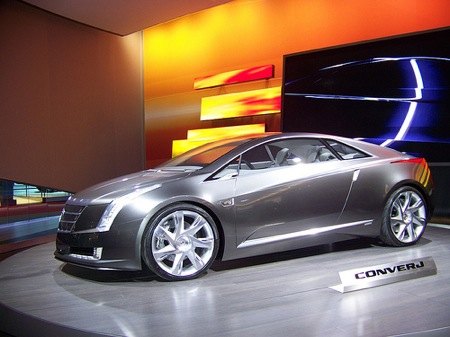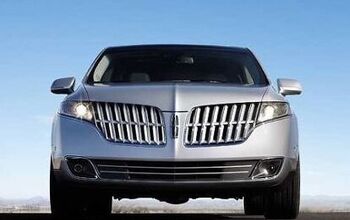TrueDelta Does Detroit Pt. 3
First, I visited the Eco drive event in the basement. In past years, they stuck suppliers and the Chinese down here. This year, with Nissan and Porsche absent and others asking for less space, most everyone moved to the main floor. So what to do in the basement? How about a lavishly landscaped road course on which to sample hybrids and such?
The public will only be able to ride along; it’s been deemed too risky to let them drive. The press gets to drive, but only up to 10 mph, with a guide in the passenger seat. One guide talked my ear off– you’d think I’d never driven a car before- but the others were mercifully silent. Up to 10 mph, most hybrids and EVs feel like… any other car with lifeless steering (nothing but electric-assist systems here). To their credit, the vehicles’ brakes all felt natural; a welcome improvement from older hybrids. I sampled a Chevrolet Equinox powered by a hydrogen fuel cell. Yep, felt just like a regular Equinox, at least at these speeds.
Next, I stopped by the presentation of the “Eyes on Design” awards. Unlike most “the media are the massage” awards, the Design gongs are meaningful. Dozens of actual designers vote to decide the best vehicles at the show. Four awards are given: two for concepts and two for production cars. Unlike past years, nothing distinguished the two winners in each category. Not even first and second place.
The concept category winners were no surprise. The Cadillac Converj, based on the Chevy Volt, easily had the strongest reaction of any concept during the show. And the Audi Sportback was chock full of interesting details The only other concepts that deserved a shot were Chrysler’s 200C EV (photo in earlier post) and Volvo’s S60 precursor (photo below). Other concepts were either weird (Lincoln’s) or uninteresting (the precursor for Subaru’s next Legacy). There weren’t many concepts this year. Not much money to spend on them, and all that.
The winners in the production category were a surprise, at least to me. First up, the Audi R8 5.2. Sure the V10 is new, and I believe the body was lengthened a bit to include it, but the design isn’t new. In fact, one wonders how it even qualifies for consideration. Well, if the Malibu could win car of the year when it was a reskin of the previous year’s winner (Saturn Aura), anything’s possible.
The other winner: the BMW Z4. Which is good mainly to the extent that it isn’t bad-i.e. Bangled like the first-gen Z4. There’s nothing particularly new or exciting about it. So if an already familiar Audi and cleaned-up BMW scooped design kudos, what does this say about the designs Detroit is counting on to save it? I’m not a huge fan of the exteriors of the Buick LaCrosse, Cadillac SRX, Chevrolet Equinox, Ford Taurus or Lincoln MKT, but some of them do more for me than the BMW. Then again, the same could be said for a bar of soap.
The interiors of the Buick and Lincoln are the best yet from their manufacturers. Still, it seems that designers weren’t enthusiastic about Detroit’s 2010s. Also absent from the winners: both of Fisker’s Karmas. Apparently designers aren’t impressed when one of their own starts his own company from scratch. Or maybe they’re just past pastiche.
Finally, Tesla presented. How did they end up as the only manufacturer presenting on this sparsely attended third day? Clearly someone didn’t do their job. Or is it cheaper to present on the third day?
The focus of CEO Elon Musk’s presentation: Daimler just gave Tesla permission to announce that the Silicon Valley start-up will be supplying batteries and chargers for the upcoming Smart EV. Which will enable Tesla to reap greater economies of scale, and advance the day when electric propulsion is cheap enough for the masses. In theory.
Questions centered on Tesla’s reliance on a large number of small cells, the planned S family sedan, and what Elon Musk has learned from his venture.
Economies of scale are much greater with small cells, so it’s cheaper to use them for at least the next few years. The S sedan will cost $49,900 after a tax credit of $7,500, and will be introduced two years after they get a hoped-for Department of Energy loan. My pricing analysis: this price makes it about half that of the Fisker, so the two won’t directly compete. The Volt will be a direct competitor. In theory.
After investing $70m of his own money, Musk learned you need car people to run a car company; nearly the entire executive team has been replaced. Mr. Musk seemed a bit worn out, and less confident than the bunch across the aisle at Fisker.
Tesla also showed video of an upcoming higher-performance variant of their Elise-based roadster. Acceleration time to 60 will improve from 3.9 to 3.7. No one in the press corps seemed to care.
Michael Karesh lives in West Bloomfield, Michigan, with his wife and three children. In 2003 he received a Ph.D. from the University of Chicago. While in Chicago he worked at the National Opinion Research Center, a leader in the field of survey research. For his doctoral thesis, he spent a year-and-a-half inside an automaker studying how and how well it understood consumers when developing new products. While pursuing the degree he taught consumer behavior and product development at Oakland University. Since 1999, he has contributed auto reviews to Epinions, where he is currently one of two people in charge of the autos section. Since earning the degree he has continued to care for his children (school, gymnastics, tae-kwan-do...) and write reviews for Epinions and, more recently, The Truth About Cars while developing TrueDelta, a vehicle reliability and price comparison site.
More by Michael Karesh
Latest Car Reviews
Read moreLatest Product Reviews
Read moreRecent Comments
- ToolGuy The only way this makes sense to me (still looking) is if it is tied to the realization that they have a capital issue (cash crunch) which is getting in the way of their plans.
- Jeff I do think this is a good thing. Teaching salespeople how to interact with the customer and teaching them some of the features and technical stuff of the vehicles is important.
- MKizzy If Tesla stops maintaining and expanding the Superchargers at current levels, imagine the chaos as more EV owners with high expectations visit crowded and no longer reliable Superchargers.It feels like at this point, Musk is nearly bored enough with Tesla and EVs in general to literally take his ball and going home.
- Incog99 I bought a brand new 4 on the floor 240SX coupe in 1989 in pearl green. I drove it almost 200k miles, put in a killer sound system and never wish I sold it. I graduated to an Infiniti Q45 next and that tank was amazing.
- CanadaCraig As an aside... you are so incredibly vulnerable as you're sitting there WAITING for you EV to charge. It freaks me out.







































Comments
Join the conversation
"Tesla also showed video of an upcoming higher-performance variant of their Elise-based roadster. Acceleration time to 60 will improve from 3.9 to 3.7. No one in the press corps seemed to care." Let's not put too much importance on what the press corps likes and doesn't like. What YOU think, yes, though I mmay disagree (I like the Z4). What Car and Driver or Road and Track thinks, not so much... Where there any "average john and jane does" there when you where there? Those may or may not have been interesting conversations to overhear.
"Hopefully somebody can roll back the bounds of my ignorance here. What does “bangled” mean?" Chris Bangle, chief ruiner of BMW sheet metal among others.